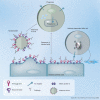Universal M2 ectodomain-based influenza A vaccines: preclinical and clinical developments
- PMID: 19348565
- PMCID: PMC2706389
- DOI: 10.1586/erv.09.6
Universal M2 ectodomain-based influenza A vaccines: preclinical and clinical developments
Abstract
Influenza vaccines used today are strain specific and need to be adapted every year to try and match the antigenicity of the virus strains that are predicted to cause the next epidemic. The strain specificity of the next pandemic is unpredictable. An attractive alternative approach would be to use a vaccine that matches multiple influenza virus strains, including multiple subtypes. In this review, we focus on the development and clinical potential of a vaccine that is based on the conserved ectodomain of matrix protein 2 (M2) of influenza A virus. Since 1999, a number of studies have demonstrated protection against influenza A virus challenge in animal models using chemical or genetic M2 external domain (M2e) fusion constructs. More recently, Phase I clinical studies have been conducted with M2e vaccine candidates, demonstrating their safety and immunogenicity in humans. Ultimately, and possibly in the near future, efficacy studies in humans should provide proof that this novel vaccine concept can mitigate epidemic and even pandemic influenza A virus infections.
Figures



Similar articles
-
M2-based influenza vaccines: recent advances and clinical potential.Expert Rev Vaccines. 2017 Feb;16(2):123-136. doi: 10.1080/14760584.2017.1240041. Epub 2016 Oct 5. Expert Rev Vaccines. 2017. PMID: 27653543 Review.
-
Intranasal adenovirus-vectored vaccine for induction of long-lasting humoral immunity-mediated broad protection against influenza in mice.J Virol. 2014 Sep 1;88(17):9693-703. doi: 10.1128/JVI.00823-14. Epub 2014 Jun 11. J Virol. 2014. PMID: 24920793 Free PMC article.
-
Complete protection against a H5N2 avian influenza virus by a DNA vaccine expressing a fusion protein of H1N1 HA and M2e.Vaccine. 2011 Jul 26;29(33):5481-7. doi: 10.1016/j.vaccine.2011.05.062. Epub 2011 Jun 12. Vaccine. 2011. PMID: 21664216
-
In contrast to conventional inactivated influenza vaccines, 4xM2e.HSP70c fusion protein fully protected mice against lethal dose of H1, H3 and H9 influenza A isolates circulating in Iran.Virology. 2012 Aug 15;430(1):63-72. doi: 10.1016/j.virol.2012.04.015. Epub 2012 May 16. Virology. 2012. PMID: 22595444
-
M2e-based universal influenza A vaccine.Vaccine. 2009 Oct 23;27(45):6280-3. doi: 10.1016/j.vaccine.2009.07.007. Vaccine. 2009. PMID: 19840661 Review.
Cited by
-
Long-Lasting Cross-Protection Against Influenza A by Neuraminidase and M2e-based immunization strategies.Sci Rep. 2016 Apr 13;6:24402. doi: 10.1038/srep24402. Sci Rep. 2016. PMID: 27072615 Free PMC article.
-
A structure and knowledge-based combinatorial approach to engineering universal scFv antibodies against influenza M2 protein.J Biomed Sci. 2023 Jul 25;30(1):56. doi: 10.1186/s12929-023-00950-2. J Biomed Sci. 2023. PMID: 37491224 Free PMC article.
-
Influenza virus-like particles containing M2 induce broadly cross protective immunity.PLoS One. 2011 Jan 18;6(1):e14538. doi: 10.1371/journal.pone.0014538. PLoS One. 2011. PMID: 21267073 Free PMC article.
-
Immunity to seasonal and pandemic influenza A viruses.Microbes Infect. 2011 May;13(5):489-501. doi: 10.1016/j.micinf.2011.01.007. Epub 2011 Feb 2. Microbes Infect. 2011. PMID: 21295153 Free PMC article. Review.
-
Prokaryote-expressed M2e protein improves H9N2 influenza vaccine efficacy and protection against lethal influenza A virus in mice.Virol J. 2013 Apr 3;10:104. doi: 10.1186/1743-422X-10-104. Virol J. 2013. PMID: 23551908 Free PMC article.
References
-
- Jefferson TO, Rivetti D, Di Pietrantonj C, Rivetti A, Demicheli V. Vaccines for preventing influenza in healthy adults. Cochrane Database Syst. Rev. 2. 2007 CD001269. - PubMed
-
- Nichol KL, Nordin JD, Nelson DB, Mullooly JP, Hak E. Effectiveness of influenz vaccine in the community-dwelling elderly. N. Engl. J. Med. 2007;357(14):1373, 1381. - PubMed
-
- de Jong JC, Palache AM, Beyer WE, et al. Haemagglutination-inhibiting antibody to influenza virus. Dev. Biol. (Basel) 2003;115:63–73. - PubMed
-
- Belshe R, Lee MS, Walker RE, Stoddard J, Mendelman PM. Safety, immunogenicity and efficacy of intranasal, live attenuated influenza vaccine. Expert Rev. Vaccines. 2004;3(6):643–654. - PubMed
Publication types
MeSH terms
Substances
Grants and funding
LinkOut - more resources
Full Text Sources
Other Literature Sources
Medical
